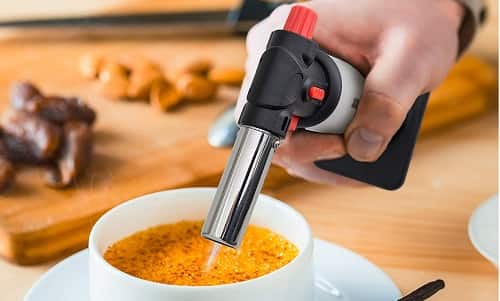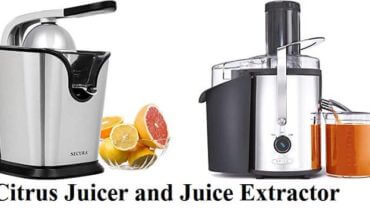How to Use a Kitchen Torch Easily {The Beginner’s Guide}
Kitchen torch is an essential tool for chefs well versed in preparing gourmet dishes. A kitchen torch is used to caramelise sugar, finishing off creme brulee, roasting bell peppers, melting cheese, searing tomato skins, glazing baked ham, making sugar crust on sponge cake, etc.
A host of gourmet recipes require a kitchen torch. Before using a kitchen torch, it is essential to understand some things so that you do not make mistakes when using it.

Buying the right kitchen torch
Table of Contents
There are many models of kitchen torches available in the market. It is better to buy a hands-free model so that you don’t have to keep the button pressed to operate it. A kitchen torch with fuel gauge is also recommended so that you can monitor the amount of fuel left in the torch. The canister required to run the kitchen torch is not provided and needs to be purchased separately.
You should not make the mistake of buying a wrong sized butane or gas canister. It is better to buy canisters which easily fit on any size of a kitchen torch.
Use metal tray
The food item on which the kitchen torch is to be used must be placed on a strong metal tray which can be anything such as steel cooking tray or grill made of cast iron. Materials such as plastic which tend to catch fire must not be present anywhere near the metal tray.
Lighting the torch
The kitchen torch must not be switched on directly over the food. You need to wait till the orange and yellow colour of the flame turns into blue and hisses in the manner of a welding torch flame. This takes a few seconds. Using the torch on the food before the flame has turned blue will result in torch taste. Torch taste is a revolting taste that the dish acquires due to contamination by the non-oxidized gases present in the flame of the kitchen torch. Hissing blue flame indicates that the gases have been oxidized. A yellow flame indicates that all the gases have not been oxidised completely.
Correct ways of torching the food
The flame of the kitchen torch must be aimed away from your other hand and whole body so that you don’t suffer burns. Your clothes must also be away from the flame. It is better to wear a kitchen apron over the clothes to avoid the risk of catching fire.
The flame of the kitchen torch must be kept some inches away from the food item to avoid scorching. The torch must be moved over the food slowly in the manner of tracing concentric circles. The torch must never be pointed at a single spot for a long time to avoid burning of the food item.
The flame of the kitchen torch can be adjusted in most models available in the market. The flame needs to kept at medium because very low flame will slow down the process while highly intense flame can burn the food item.
Common uses of a kitchen torch
Caramelising sugar is the common task for which chefs employ kitchen torches. Caramelised sugar on the top of desserts such as cakes and pies enhances the depth of the flavour. All you need to do is sprinkle sugar on the top of a cake or pie and then burn the sugar layer with a kitchen torch for some seconds. The heat from the kitchen torch caramelises the sugar and makes the cake or pie more delicious. Sugar can also be caramelised on top of fruits such as peaches or grapes.
Kitchen torch can be used to roast peppers instead of stovetop or broiler. Place the pepper in a sheet pan lined with aluminium foil and move the kitchen torch all over the pepper until the skin is blackened. Tongs need to be used to turn the pepper on the other side so that the entire skin is blackened.
Meringue topping on desserts such as pies or fruit tarts can be caramelised using a kitchen torch. The kitchen torch needs to be moved over the meringue topping on the dessert until it turns light brown.
Kitchen torch can also be used to make grill marks on steaks, meat, burger, etc. You need to move the kitchen torch over the dish to make a series of lines to mimic the look of a grilled dish.
Precautions
The nozzle of the kitchen torch tends to get dirty after use and can also harbour small food particles. This disturbs proper aiming of the flame. Food particles sticking to the nozzle can even get in the dish. Thus, it is important to wash the nozzle using a dishcloth or rag.
The gas supply of the torch needs to be turned off immediately after use. You should not forget to turn off the gas before storing the torch.


